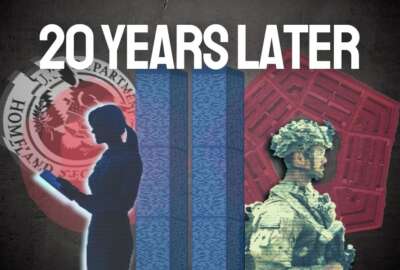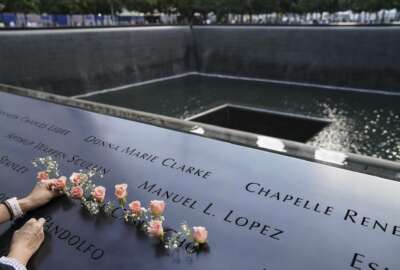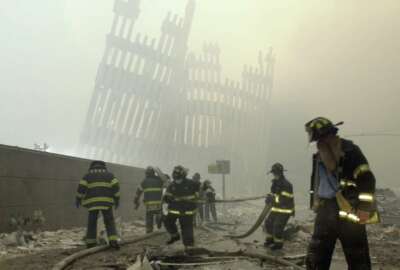A Tuesday like no other: An oral history of 9/11 through the eyes of federal employees
On 9/11, some feds spent hours in traffic going home. Others stayed at the office. And some were right in the thick of recovery efforts at ground zero.
Editor’s Note: For the 20th anniversary of 9/11, Federal News Network gathered the personal stories of federal employees who were on duty that morning. We believe their stories are just as relevant today as they were then. We hope you agree.
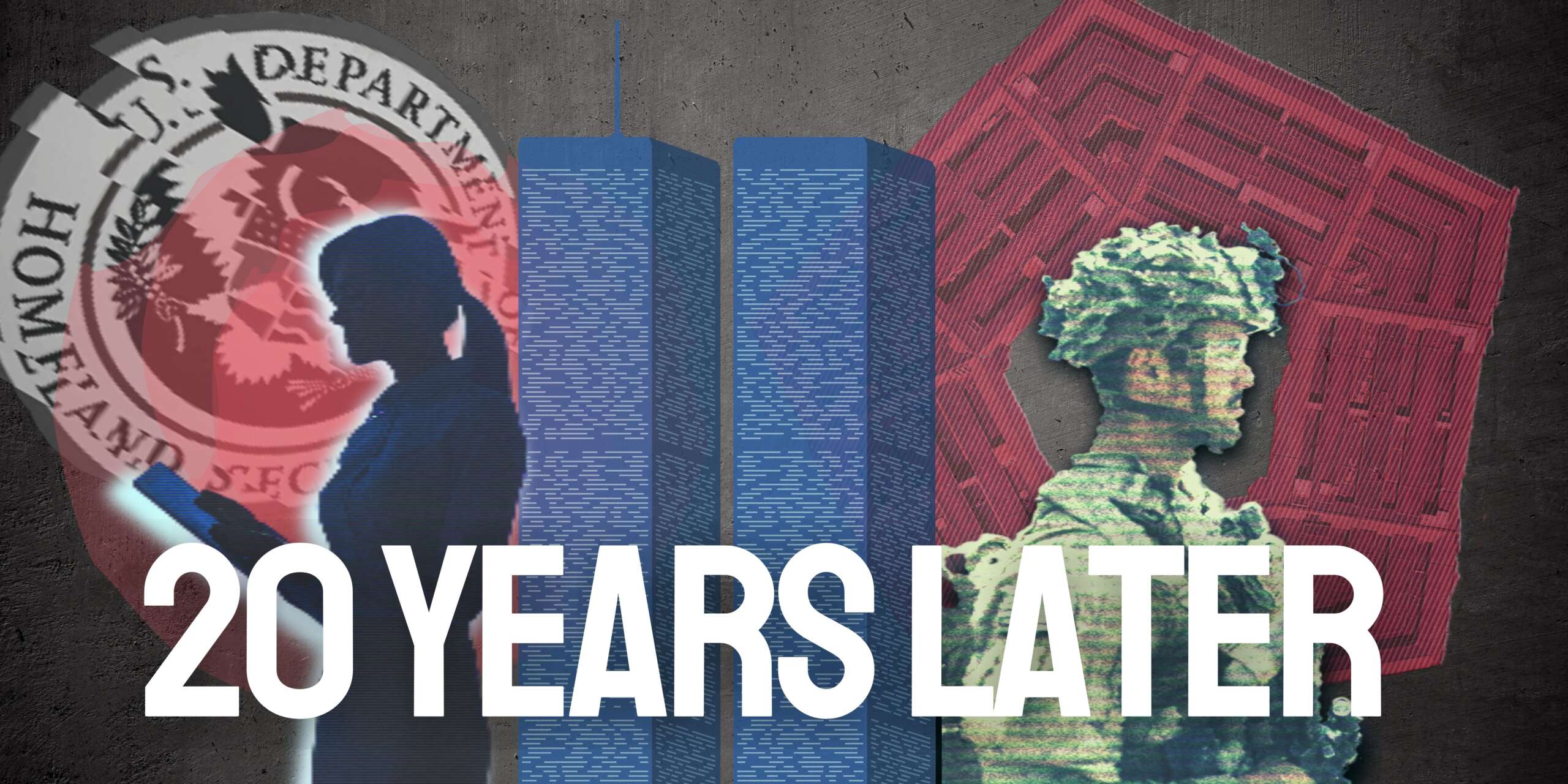
As part of its special report, “A Tuesday like no other,” Federal News Network spoke with several current and former federal employees and executives about their recollections of Sept. 11 and the days after.
For some, the attacks in New York and at the Pentagon prompted them to respond. Many federal employees spent hours trying to get home. Some stayed at the office to write guidance, while others worked on recovery efforts.
For others, the day’s events eventually inspired them to join the federal government or take on new responsibilities fighting terrorism.
These are their stories.
Christopher Gu, supervisory special agent with the State Department’s Diplomatic Security Service: A group of agents and I were having breakfast at the 26 Federal Plaza cafeteria when the first plane hit. It was a huge boom that vibrated through the building, and we didn’t know what it was. I personally thought maybe it was an elevator accident of some sort, but the building shook. A colleague of mine was sitting near a window, got up, looked out the window and turned around very calmly just said, “I think the World Trade Center is on fire.” We’re like, “What?” Yeah, the World Trade Center is on fire. So we all got up, and we stared out the window. Smoke was billowing out of Tower One, and papers were flying through the air like confetti. We all raced back to the office.
I did not hear the second plane hit. I did not feel it.
Elizabeth McAleer, assistant special agent in charge of the State Department’s New York Field Office of Diplomatic Security, was sitting at her desk at 26 Federal Plaza, blocks away from the World Trade Center. When the first plane hit the first tower, she and her colleagues grabbed their radios and left the building. They took the stairs from 34th floor and met outside on the street when one of the towers started to collapse.
McAleer: It felt like the building was coming towards us. We weren’t many blocks away, and people just started running north. When they started running north, they were just pointing to the buildings collapsing. It was so surreal. Nobody was screaming, just mouths were open, and then people were just falling all over the place. We were picking people up, people were crying in the street. The smoke and the dust and the debris were just coming towards us. It was absolutely horrific.
Mike McGill, former public affairs officer for the General Services Administration’s national capital region: I went to work as usual by Metro. I got to my office, and I was sitting at my desk working on projects. My wife called and said a small plane has hit the World Trade Center, one of the World Trade Center towers. And I said, “Oh, that’s terrible. It’s a horrible accident.” And then she called a few minutes later and said, “I just saw a second plane hit the other tower.” She and I knew right then this is not just an accident; it’s a terrorist attack of some kind.
Kathy McGettigan, senior adviser to the director of the Office of Personnel Management: On 9/11 I was [chief financial officer of the agency] at that time. I was actually waiting in the director’s suite for a meeting when the first plane hit the World Trade Center. I had worked for many, many years in downtown Manhattan and had been to the World Trade Center offices. At first the reports were sketchy. I thought it was probably an accident involving a small plane, but of course it became apparent that it wasn’t. The meeting was canceled and I went back to my office. 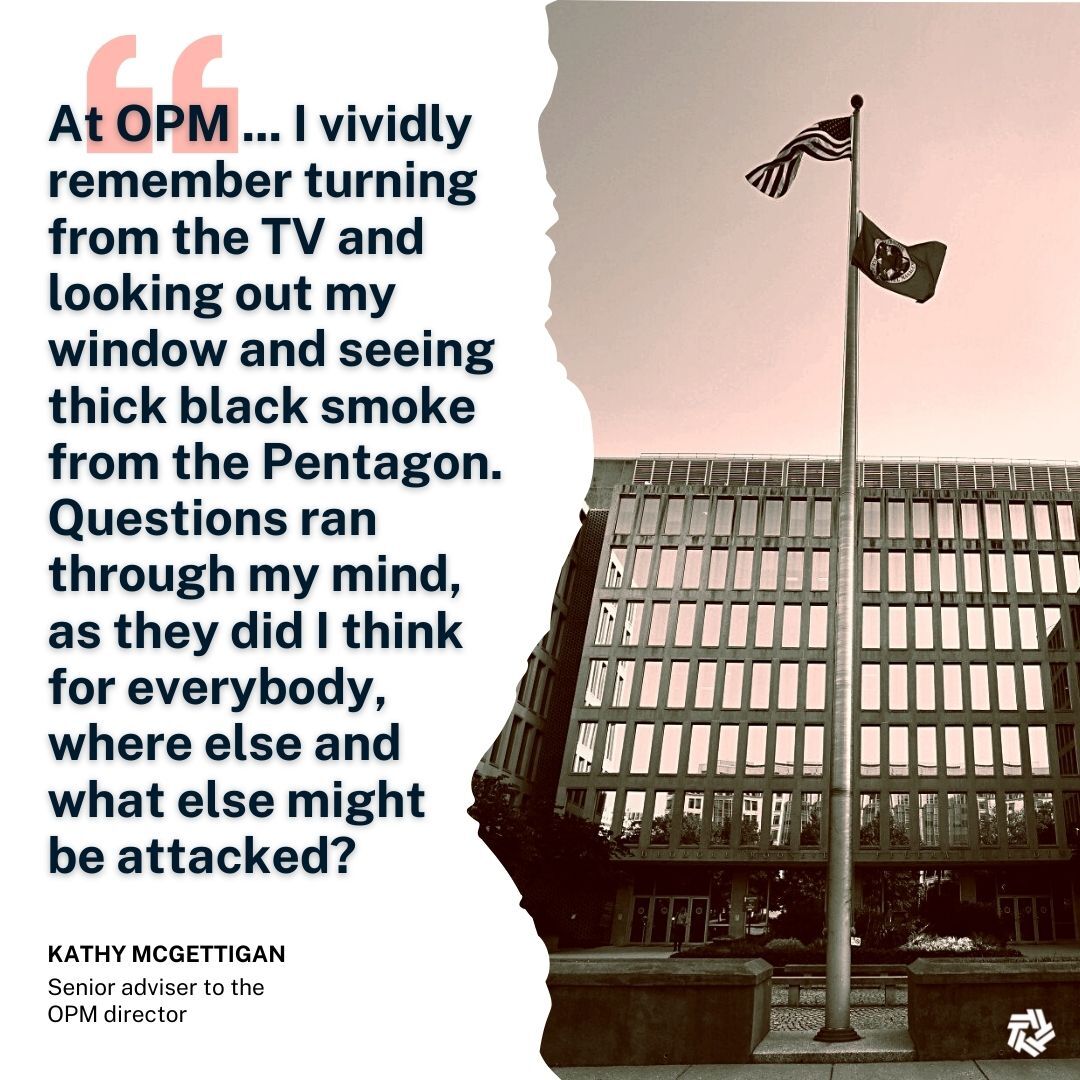
On a personal level … I was certainly most concerned because several family members were working at the World Trade Center.
Bill Csontos, a security director for the Transportation Security Administration, worked for the Connecticut State Police Force’s Scientific Canine Training Unit on Sept. 11. He sat in his truck planning for the day’s work when he heard news of the first plane hitting the World Trade Center.
Csontos: Myself and the other members of the unit gathered and made the phone call back to our headquarters, I think we all knew what it was at that point. And then we were ordered to stop activities for today and immediately respond to ground zero. We basically left with our clothes on our on our back, with our dogs. We caravanned down to the city to assist with at first the rescue and then the recovery mission at ground zero.
Brenda Roberts, deputy associate director of pay and leave, OPM: On 9/11 I was the junior staffer at the time. But I worked in the office, and I still work in the office, that releases people when there’s some kind of emergency that happens in the Washington, D.C. area. I’ll never forget the day, because we got put on alert when the first plane hit the World Trade Center. And then the second plane hit. It was just like everybody started realizing it was something that we needed to take action on.
McGill: I went down the hall to see my boss, who was Tony Costa — he was the assistant regional administrator for the Public Building Service in GSA’s National Capital Region — to tell him. He was in a meeting, I told the secretary, she said let’s go in and interrupt him. We did. He immediately kicked into action. He had already scheduled a nine o’clock meeting among senior management, and so we went to that meeting.
Tony Costa, former assistant regional administrator for the GSA’s Public Buildings Service in the national capital region: When it became clear that this wasn’t an accident and there were ongoing threats, we started to hear that employers and folks who work in D.C. were trying to get out and trying to understand and protect their families, get their kids, etc. So, clearly, what started to unfold was traffic, people trying to decide whether to leave work or go home.
In New York, Gu and McAleer were told to leave the area and wait for more directions.
McAleer: I was told that the Secretary of State’s two daughters who lived in Manhattan
at the time, Colin Powell, his adult children, needed to be secured. So I had to go back downtown to get some armored vehicles. And I wound up picking up one of Colin Powell’s children at work, and then bringing her to a safe haven. And another agent picked up his other daughter and brought her to the same safe haven. And we stayed with them probably until 11:00 that night, and they were secure. We had a post with them over the midnight shift, and I think I got home probably at about two o’clock in the morning.
Joe Gradisher, retired Navy Captain and current civilian public affairs officer for the Navy: I was in the Navy’s Office of Information in the Pentagon, known as the chief of information office or CHINFO. I was the deputy chief of information for the U.S. Navy. I was still on active duty at the time as a Navy captain and a career public affairs officer. So I was in CHINFO that morning, just like any other day of the week. I remember it being a bright, beautiful, clear morning, slightly cool.
Gradisher saw the first and second planes hit the World Trade Center from the TVs in his office. He and his colleagues began discussing how the public affairs office should respond.
Gradisher: I was actually in the office with the admiral, when, with no advance notice at all, we got hit.
I had my back to the window in the direction where the plane came in, because there’s windows on the inside of the building and overlooking this alleyway in between the B and C ring. And there was just one huge BAM! And then the concussion, the pressure change. And I ducked because it felt like whatever was coming into the building, whatever was causing the explosion was coming right over my shoulder.
At GSA, Costa told McGill and others to create an open line of communication to the Federal Protective Service, which was a part of GSA at that time. They talked about the possibility of closing and securing federal buildings in Washington, and they agreed to reconvene and meet in an hour. The next time they met, the Pentagon had been hit.
McGill: GSA does not manage the Pentagon, but we rent space for them elsewhere. [Costa] said… start finding replacement space for the Pentagon. They went to work immediately. As we were talking, his boss, the regional administrator, came in and whispered in his ear. He said there’s another plane in the air. We didn’t know where it was going, and we even looked out the window to see what was coming for us.
Eileen Roemer was an FBI agent and Navy reservist who was serving on active duty the week of 9/11. That day she finished her shift at the Navy Command Center in the Pentagon just before the attacks started. The Command Center was among the offices directly in the line of attack.
Eileen Roemer, FBI agent and Navy reservist: I had gone in the night before and stood watch all night, and left the building at about 8:45 a.m., maybe a little before that, and drove to my home in Fredericksburg. And so when I got home, I had a phone call from a New York friend, who said, “Did you see what’s going on?” I turned the TV on, and the towers had been hit. And it wasn’t long after that, that there was smoke coming out of the Pentagon. There’s really no video of the plane going into the Pentagon … So I tried calling the desk in the Pentagon for hours and hours. And of course, nobody ever answered.
Gradisher: We were fortunate that day that the plane hit a section of the building that had just been renovated, so there was extra reinforcement of the concrete and the windows and everything on the outside of the building. That was all in response to what had happened in Oklahoma City with the federal building that was taken out by a truck bomb a couple years earlier. But that extra protection kept the plane from continuing under us. And for me personally, it kept the window I was standing next to, it kept it from shattering.
I looked out the window, and the window itself was just rattling back and forth and bowing in and out just because of so much pressure. About that same time, the fireball passed over the top of our head and created a vacuum in that alleyway, so there was smoke and debris and things flying all over the place. And then it kicked in: All right, we need to get everybody out of here. So we gathered everybody, about 60-65 people in CHINFO at the time, and shepherded them out of the building.
McGettigan: At OPM, we continued to watch the reports and speak with staff and tried to calm people down, because people obviously were very upset. I vividly remember turning from the TV and looking out my window and seeing thick black smoke from the Pentagon. Questions ran through my mind, as they did, I think, for everybody, where else and what else might be attacked?
Kathie Whipple, deputy general counsel, OPM: Like Kathy, I saw the smoke from the Pentagon. We lived through several waves of rumors that the State Department had been hit, because from our angle of the building, it looked like smoke was coming from the State Department as well. That really evoked a lot fear that any agency could be hit.
Because there was an announcement in the building that we should leave, I did take my leave that day. My partner walked across town; I had the car.
We have a park across the street from us that divides the eastbound and westbound lanes of E Street. Cars were actually driving through the park over the sidewalk to try to get to the tunnel. I remember that because I had stupidly suggested I meet my partner there.
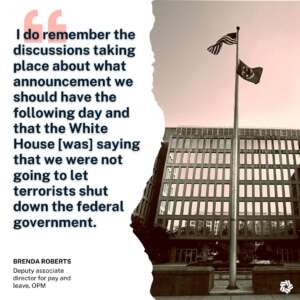 Roberts: At that time I had three young children, and I had a baby at the time. My two bosses… told me to go home. I went out of the building with my friends. It was just like total chaos. It was like being in a disaster movie. The cars were piled up and you couldn’t get across the street. It was just bad. My friend and I got across to where my van pool was parked, and I found out my van pool left me. There were no cell phones, so you couldn’t be in touch with people that day. I was stuck.
Roberts: At that time I had three young children, and I had a baby at the time. My two bosses… told me to go home. I went out of the building with my friends. It was just like total chaos. It was like being in a disaster movie. The cars were piled up and you couldn’t get across the street. It was just bad. My friend and I got across to where my van pool was parked, and I found out my van pool left me. There were no cell phones, so you couldn’t be in touch with people that day. I was stuck.
In New York, Csontos and his team drove into New York City and arrived at ground zero. They took their lead from the New York City Fire Department.
Csontos: At that point we walked into the scene, and I liken it to a movie set. With everybody running around in the smoke and the flames, it was almost … It was eerie silence, even with all the activity going on. It was a little overwhelming at first, but knowing what we had to do, we paired up with my fellow troopers, went in and we just started work.
In Washington, Roberts decided to go back inside the OPM building to help her bosses develop guidance for federal agencies that day. She managed to place two calls before the phone lines shut down in the building, one to her neighbor and another to her children’s day care center.
Roberts: Back in the day we used to call agencies and release them. We were trying to figure out do we need to call the agencies? Do we need to get them out of the city?
During emergencies and other weather events, OPM is the organization that determines when and how agencies should release their employees. OPM did issue guidance on Sept. 11, closing federal buildings in Washington, D.C. and ordering employees to go home.
Roberts: I think it happened so fast that agencies released before we got to them. That was my recollection.
McGettigan: I think that’s right, that people weren’t waiting for OPM.
Whipple: The agency does have the authority to release their staff if they need to, because they know those circumstances at their building. OPM generally provides the guidance that agencies follow, but on that day agency heads were doing what they thought was best without waiting to hear from us. Although I think they were very eager to hear from us about the next day.
McGettigan: Of course releasing everybody in that manner is what jammed everything up. It wasn’t an orderly way.
Whipple: I think that’s one of the lessons that we learned.
McGill: For the rest of the day, I was coordinating and updating the phone contact list so we had the proper home phone for all of our senior managers in case they needed to work from home. We finally got instructions to close down the building, so we started closing down the buildings.
Costa: We knew DoD would need help. And obviously we were in contact with them immediately. But in the first hours, it was about life and protecting life. We just wanted to make sure DoD understood we were ready to help when they needed it.
Gradisher: We ended up setting up a temporary Navy headquarters in the Virginia Department of Transportation building. We got the Secretary of the Navy and his staff and the Chief of Naval Operations and the vice chief and their staffs and CHINFO, and we reconstituted a Navy headquarters there. It became part of our mission that day to try and figure out a way to account for everybody that was in the building from the Navy, because there was no easy way to identify who was there and who was not. There was no good record keeping on any given day. You couldn’t just put out something on a cell phone — the cell phone network shut down. So we instituted a 1-800 number to get people to call in to try and account for all the Navy people because we needed to find out who was missing and how extensive the damage was.”
OPM spent the rest of the day coordinating with the White House on the plans for the following day, Wednesday, Sept. 12.
Whipple: The cluster of people in the OPM director’s office spent the day trying to pass information on to agencies about what should be happening, to give them advice about whether they should close or not and what kind of announcements they should make to their staff. I know they also started thinking about what to do about the next day. The decision was made that people should come back to work.
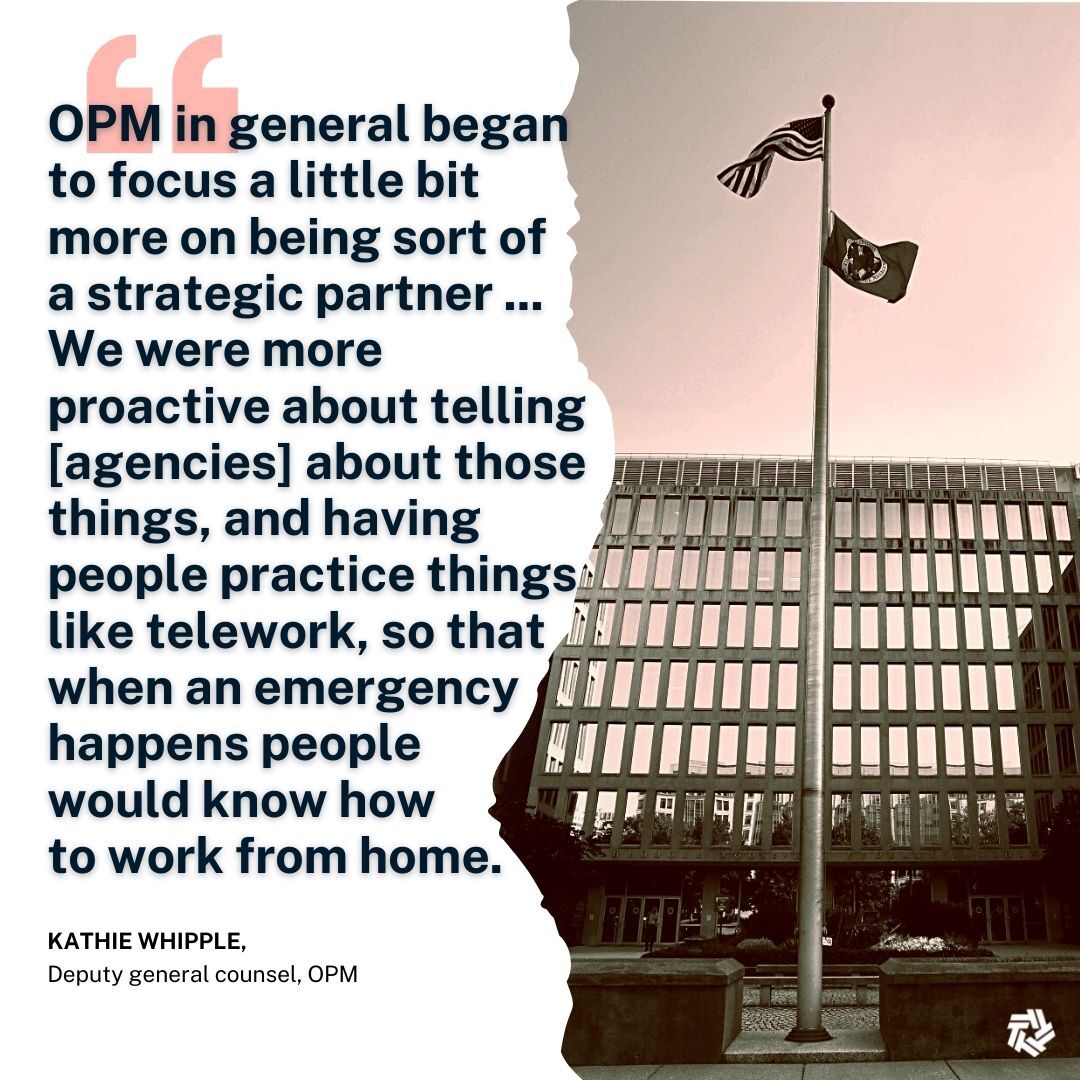 Roberts: I do remember the discussions taking place about what announcement we should have the following day and that the White House [was] saying that we were not going to let terrorists shut down the federal government. The announcement was very clear that we were going to be open the next day.
Roberts: I do remember the discussions taking place about what announcement we should have the following day and that the White House [was] saying that we were not going to let terrorists shut down the federal government. The announcement was very clear that we were going to be open the next day.
Gradisher: Many people left keys, wallets, purses, all those things in the offices. And my car was parked in the Pentagon South parking lot, just a few feet away from where the plane hit, so it was weeks before I could get my car out of there. We had a late night, it went, I don’t know, 11:00 or 12:00 at night.
Gradisher walked the two miles home in the dark. He returned to work the next morning.
Gradisher: Bright and early the next morning we were at the Navy annex, working on overturned cardboard boxes in the very small public affairs office [with] the one computer that worked. [We were] trying to find some place we could plug laptops in just to give us capabilities. So it became, over the next few days, it was quite an effort to try and reconstitute and keep moving forward.
OPM allowed federal employees to take an excused absence the following day on Sept. 12. The agency established an emergency leave transfer program for employees impacted by the events in New York and the Pentagon. It encouraged federal employees to give blood.
Whipple: Almost everybody came back, that’s what I remember. People wanted to do something to help. In the next few days we put out guidance reminding agencies of what workforce flexibilities were available to them, hiring authorities. I think at some point we set up a hotline for retirees to call in and let folks know that they’d be interested in coming back to work on projects related to 9/11 if there was a need.
GSA secured temporary space for the Pentagon to use while search and recovery operations continued.
Costa: We happened to have a vacant space in Crystal City. It wasn’t ready for occupancy, but we had vacant space and we’re pretty lucky that that was available.
The GSA team worked as hard as I’ve ever seen people work to make sure that DoD folks — the folks who were charged with protecting us, protecting the country — had space to be able to do their jobs. We worked 24 hours through the weekend to make sure that happened. I remember visiting. We were able to get space ready, really in a matter of days, and that was really unheard of.
McGill: As a result of our efforts to find replacement space, we managed to secure 800,000 square feet of space in Crystal City, Virginia, for the Pentagon to use on a short term basis. [My boss] Tony Costa said to our staff, “OK start preparing that space so they can move in as fast as possible.” They began furnishing it and setting up the data processing and so on. Within two weeks, that space was ready for occupancy and they moved in.
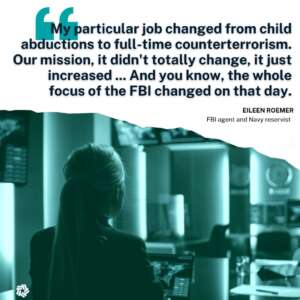
Recovery operations continued at the Pentagon, Roemer, who trained cadaver dogs with a volunteer group, got a call from the FBI Washington field office.
Roemer: Sunday night, we set up a staging area. What they were doing was bringing debris from inside the Pentagon, loading it into trucks and bringing it around to North parking, where they had a privacy area set up. They would dump the truck contents into the parking lot. There was an evidence response tent set up next to this … Body recovery dogs generally work off leash, so they would look at the pile. They always found something. We wondered if they would, because of the heavy fuel, you know, because the fuel tank was full on the airplane. So having never trained in that kind of an environment, we didn’t know what they would be able to do. But you know, that scent … I guess they know that scent.
It was the 16th to the 27th. So 12 days, starting at midnight on the 16th.
In New York, Csontos spent 12 days at Ground Zero. He worked with his German shepherd, Odin.
Csontos: From about 5:00 a.m. until I think it was 8:00 or 9:00 at night, we would continue working in shifts with our dogs, going in and responding to those areas. Unfortunately, we didn’t find anybody alive. We realized that pretty quickly on that it was going to become a recovery mission. But that gave us some solace as well, knowing that we would be returning family members, and that would give them obviously some closure. The majority of the mission was a recovery mission at that point.
McAleer spent the next several days driving FEMA employees, who needed to install lights and other equipment at ground zero. Gu spent weeks driving emergency personnel to and from fire stations and hospitals.
Gu: The following week we were running supplies. We were offloading emergency supplies and food. We were transporting collected evidence to the FBI, the Joint Terrorism Task Force. We were doing everything that was required of us, whatever’s necessary.
For Gradisher, the Navy public affairs officer, Sept. 11 helped him realize he was working in the right field, doing work he wanted to do. He retired from active duty in 2005 and eventually returned to the Navy as a civilian public affairs officer.
Whipple: I looked up something that Kay Cole James said in an article recently. She was the director then. She said she had witnessed the federal workforce commit a million acts of quiet defiance against terrorism by returning to work. She’s exactly right.
Roemer eventually went back to work at the FBI. Sept. 11 and the days that followed inspired her to begin working in counterterrorism at the FBI.
Roemer: Remember, I was relieved at 8:30 in the morning by someone who was killed in that room. I knew a lot of those active duty people and the few reservists who were in there. I worked with them. I greeted them when they came in. Actually, in the years prior, I had always done my active duty in the daytime. This was the first time, that year, that I worked midwatch. So I knew the people who work there in the daytime as well. And so I was looking for them … not looking for them-them, but you know what I mean? I was trying to recover all of them. And I remember people saying wasn’t that difficult? I said, “No. It was wonderful.”
Because I was one of the few people who felt like I was doing something. I mean, there were a lot of agents who weren’t pulled in to work this case. And I’ve heard from so many of them. They wished that they could do something, they felt so helpless. They wanted to be working that case. . . . I have told people that the most important work I think I will have ever done in my life is with those dogs in North parking.
Thinking back to her State Department colleagues gathered on the street that morning, McAleer said the instinct was to send people to the towers to see how they could help. Instead, the agency sent people home. McAleer said she’s since realized that was the best call they could make at the time.
McAleer: Personally, it’s made me a better manager, because I now assess situations more than I did back then. I don’t take those unnecessary risks with others, as I would have, as I did back then. It was a hard lesson, one that I struggled with immensely over the years. Just make sure that you don’t put people in harm’s way.
Csontos retired from his job at the Connecticut State Police Force in 2007. Sept. 11 stuck with him. He joined TSA as a canine coordinator in Washington, then returned to Connecticut overseeing aviation security in the state. He shares his story with new TSA officers joining the agency on the first day of orientation.
Csontos: I try to do that as much as I possibly can with our officers. I just don’t want this to be a job for them. I want this to obviously be an impactful mission — where they have some some satisfaction that they know every single day when they go home that nothing happened on their watch. Sometimes that’s difficult.
I have never forgotten. It’s every day that I remember 9/11, maybe because I was there during the rescue recovery mission. Maybe it’s because of my job and what I do right now with aviation security. But people should not forget.
Copyright © 2024 Federal News Network. All rights reserved. This website is not intended for users located within the European Economic Area.



